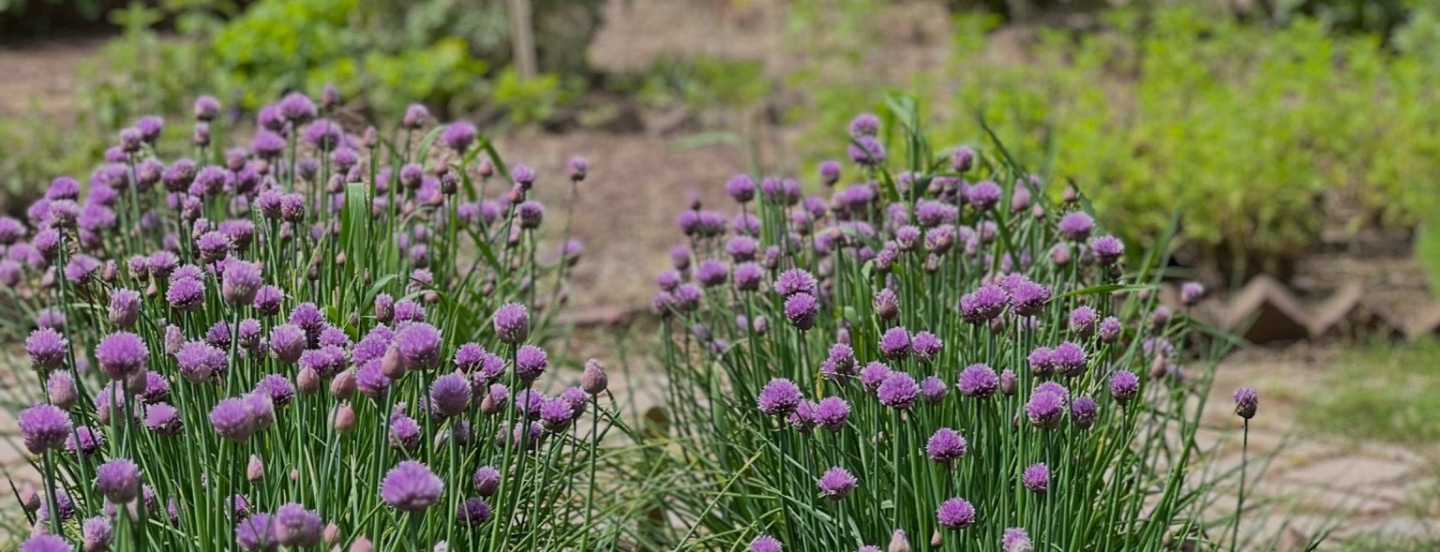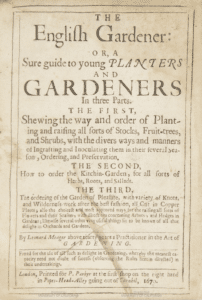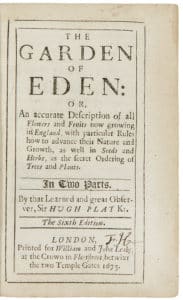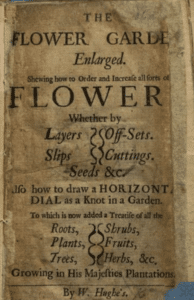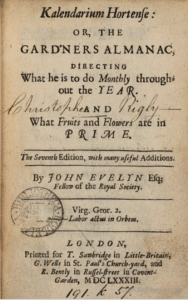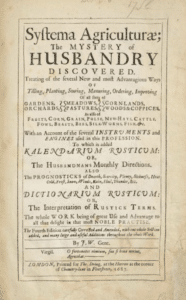
For reservations to experience “nkwiluntàmën: I long for it; I am lonesome for it (such as the sound of a drum)” by Indigenous artist Nathan Young, please go to https://nkwiluntamen.com/
Gardening in the 17th Century
The English were skilled horticulturalists, participating in the exchange of plants and information throughout Europe and the colonies. Penn encouraged his gardeners to collect plants from the surrounding forests for use in the kitchen garden and shipping back to England. Quakers, like Penn, supported gardening and studying nature as a way of learning about the works of God.
The position of an estate gardener was an important one. Gardeners needed to be able to read and write, be physically fit, and intelligent. The position was second only to the steward, and the gardener would assume responsibility if there was no steward. Gardeners at Pennsbury included Ralph Smith, a man referred to only as Nicholas, James Reed, and Hugh Sharp. James Reed was gardener from 1685-1687. Reed most likely was a well connected professional and participated in the plant collecting and sharing taking place in England. From his letters, it appears that Penn only collected for other people, not for his own garden. This is most likely why Reed left Pennsbury after his indenture was up, as the work was not challenging.
-
-
Kitchen Gardens
The kitchen garden provided fruit, vegetables, and herbs for the Penn family and for the rest of the household. This was a cheaper way to provide food for the plantation, as well as provide plants for medicinal purposes. We know that Penn requested flowers be planted in his garden, to be cut and used as decoration in his manor house. The gardener was responsible for the kitchen garden, but also relied on the cook’s expertise in providing food for the entire plantation. The gardener also would inform the cook when certain food items needed to be used.
-
-
Gardening Books at Pennsbury
The following books were listed on the 1687 inventory taken at Pennsbury Manor, “boocks taken out of the Governors Closet and now in the Custadey of James Reed Gardener.” For access to digitized copies, click on the image of each title.
The Manner of Raising, Ordering, and Improving Forest-Trees
Author: Moses Cook, Head Gardener to the Earl of Essex
Moses Cook was hailed as “so skillful an artist” because of his work in garden design and his “incomparable collection of the choicest fruits.” This influential book covers care for familiar types of trees, such as oak, ash, and walnut, and less familiar, such as lime trees, hornbeam, and quickbeam. Cook explains the best times for planting trees, how to understand and grow seeds, how to grow from cuttings, and landscaping techniques. A recipe for cider made from apples or pears is also included.
The Planters Manual
Author: Charles Cotton
Cotton originally wrote The Planters Manual for a friend, later deciding to publish it. This book discusses the planting and “ordering” of fruit trees, detailing the best times to plant and harvest. Cotton includes definitions of planting terms and the various fruits as he discusses them, making this an accessible and helpful resource for new gardeners.
The English Gardener (or a Sure Guide to Young Planters and Gardeners)
Author: Leonard Meager
Leonard Meager was a gardener for thirty years. He explains best practices for caring for trees and shrubs, as well as advising on how to best lay out a garden landscape. This book was intended for estate gardeners, rather than the general public.
The French Gardiner
Author: Nicholas de Bonnefons
John Evelyn, a fellow of the Royal Society and also author of Kalendarium Hortense, translated this title from French to English. Nicholas de Bonnefons discusses soil, and how to remedy “ill ground” (p. 1), espaliers, best choices for fruit trees, nursery care, and grafting. The second section of the book focuses on the fruit and vegetables themselves, including herbs. de Bonnefons includes an appendix on preserving fruits, including methods such as pickling, preserving in liquid, and drying.
The Garden of Eden
Author: Sir Hugh Plat
Sir Hugh Plat claims that “all Ladies and Gentlemen by reading these few leaves may not only advance their knowledge and observation when they walke into a Garden, but discourse more skillfully of any Flower, Plant, or Fruit then the Gardiner himself, who (in a manner) growes there night and day” (p. 10). Sir Hugh doesn’t bother with planning out garden beds or hedges, but instead focuses on things that are often overlooked, such as the soil. He also covers the “secrets” in the ordering of trees and plants, as well as grafting. This book covers a wide variety of topics specific to English gardening, providing Plat’s experiential knowledge on the various plants and techniques.
The Flower Garden
Author: William Hughes
This book was “chiefly intended” for the average person, help “ordinary country people” grow their own flower garden (p. 72). William Hughes provides instructions for building hot beds and decorative dials. The Flower Garden also offers a list of flowers, showing what time of year they bloom, as well as bibliographical references for further reading.
Kalendarium Hortense
Author: John Evelyn (Evelin)
John Evelyn was a fellow of the Royal Society. In Kalendarium Hortense, Evelyn goes month by month, explains what work needs to be done in the orchard, olitory (kitchen) garden, flower garden, and conservatory. The book includes a table reference for each plant and horticultural technique. There is also advice for taking care of beehives.
Systema Agriculturae
Author: John Worlidge
Systema Agriculturae covers wide array of subjects, including gardens, meadows, “cornlands,” orchards, pastures, woods, and coppices. Worlidge also discusses the care of animals and the removal of pests. He includes a dictionary of terms used throughout book.
